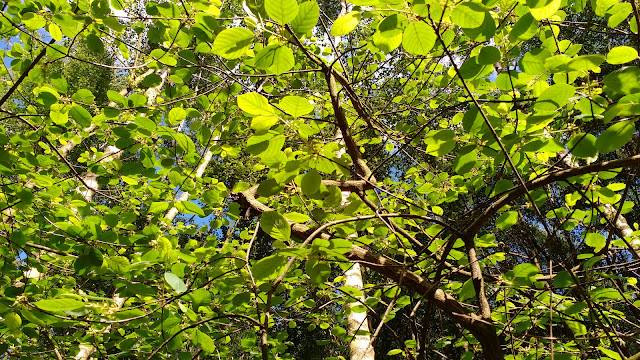I wanna strim it with you
We're strimmin' strimmin'
And I hope you like strimmin' too
(thanks to Bob M)
Well, brush-cuttin' rather than strimming actually, with the new multi- tool, which has changeable heads that can do a multitude of woodland work. The problem with most bits of machinery is that they're not really made for lightish weight women under 5ft 4ins. The fuel tank adds to the weight, and the harness that supports it need a lot of adjusting to make it comfortable for the smaller person. But no doubt we'll get used to it with a bit of practice Thankfully, starting it was easy.
First task was to tackle the timber storing area where the cut Scots Pine was stacked prior to collection during the Big Thin of late 2015. After the logs, tractor, lorry and assorted machinery left, this space was a deeply churned up, rutted mudbath. It was difficult to imagine anything much growing there, but within 18 months a veritable meadow had appeared complete with grasses and wild flowers. It gets a lot of sun, and this summer found it buzzing with bees and butterflies. Keen to encourage this, and to maintain the grassland flora, we waited until the vegetation had set seed, and then today cut it all back. We'll remove the 'arisings' (woodspeak for the cut vegetation) when we next visit, and wait to see what the result is next Spring/Summer. Autumn/winter is the time for attending to this as it allows a full life cycle of plants and associated insects to be completed.
 |
| Next brushcutting job; the bluebell track through the birch. |
 |
| George and Herbie off to investigate what Sarah is doing. |
Then, at the Ride edge, Sarah had a go at cutting back some tussocky tall grass, and bramble that was spreading onto the Ride. Increased light levels have encouraged thuggish bramble, which though valuable for wildlife can quickly take over and smother more delicate plants. We hope that judicious removal, combined with an ongoing programme of tree and shrub layer planting will in time, control its spread by shading it out.
 |
| Fly Agaric (Amanita Muscaria) pushing its way out of the earth |
 |
| A fine patch of them in a sunny spot on the edge of the wood |










